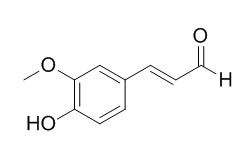Coniferaldehyde
Coniferaldehyde exerts anti-inflammatory properties by inducing heme oxygenase-1(HO-1), it inhibits LPS-induced apoptosis through the PKC α/β II/Nrf-2/HO-1 dependent pathway in RAW264.7 macrophage cells. Coniferaldehyde can significantly inhibit the growth of viability of strains of Oenococcus oeni.
Inquire / Order:
manager@chemfaces.com
Technical Inquiries:
service@chemfaces.com
Tel:
+86-27-84237783
Fax:
+86-27-84254680
Address:
1 Building, No. 83, CheCheng Rd., Wuhan Economic and Technological Development Zone, Wuhan, Hubei 430056, PRC
Providing storage is as stated on the product vial and the vial is kept tightly sealed, the product can be stored for up to
24 months(2-8C).
Wherever possible, you should prepare and use solutions on the same day. However, if you need to make up stock solutions in advance, we recommend that you store the solution as aliquots in tightly sealed vials at -20C. Generally, these will be useable for up to two weeks. Before use, and prior to opening the vial we recommend that you allow your product to equilibrate to room temperature for at least 1 hour.
Need more advice on solubility, usage and handling? Please email to: service@chemfaces.com
The packaging of the product may have turned upside down during transportation, resulting in the natural compounds adhering to the neck or cap of the vial. take the vial out of its packaging and gently shake to let the compounds fall to the bottom of the vial. for liquid products, centrifuge at 200-500 RPM to gather the liquid at the bottom of the vial. try to avoid loss or contamination during handling.
Appl. Sci. 2021, 11(22),10569
J Nat Prod.2021, 84(9):2544-2553.
Inflammation.2021, doi: 10.1007
Advances in Traditional Medicine2020, 10.1007
Food Funct.2020, 11(2):1322-1333.
Mol Biol Rep.2023, 50(5):4029-4038.
ACS Synth Biol.2020, 9(9):2282-2290.
Toxicol In Vitro.2024, 99:105876.
J Bone Miner Res.2017, 32(12):2415-2430
Biomed Pharmacother.2023, 166:115329.
Related and Featured Products
Chem Biodivers. 2013 Jul;10(7):1322-7.
Heat shock factor 1 inducers from the bark of Eucommia ulmoides as cytoprotective agents.[Pubmed:
23847077]
The barks of Eucommia ulmoides (Eucommiae Cortex, Eucommiaceae) have been used as a traditional medicine in Korea, Japan, and China to treat hypertension, reinforce the muscles and bones, and recover the damaged liver and kidney functions.
METHODS AND RESULTS:
Among these traditional uses, to establish the recovery effects on the damaged organs on the basis of phytochemistry, the barks of E. ulmoides have been investigated to afford three known phenolic compounds, Coniferaldehyde glucoside (1), bartsioside (2), and feretoside (3), which were found in the family Eucommiaceae for the first time. The compounds 1-3 were evaluated for their inducible activities on the heat shock factor 1 (HSF1), and heat shock proteins (HSPs) 27 and 70, along with four compounds, geniposide (4), geniposidic acid (5), pinoresinol diglucoside (6), and liriodendrin (7), which were previously reported from E. ulmoides.
CONCLUSIONS:
Compounds 1-7 increased expression of HSF1 by a factor of 1.214, 1.144, 1.153, 1.114, 1.159, 1.041, and 1.167 at 3 μM, respectively. Coniferaldehyde glucoside (1) showed the most effective increase of HSF1 and induced successive expressions of HSP27 and HSP70 in a dose-dependent manner without cellular cytotoxicity, suggesting a possible application as a HSP inducer to act as cytoprotective agent.
Food Microbiol. 2008 Feb;25(1):105-12.
Effect of phenolic aldehydes and flavonoids on growth and inactivation of Oenococcus oeni and Lactobacillus hilgardii.[Pubmed:
17993383 ]
The aim of this work was to investigate the effect of wine phenolic aldehydes, flavonoids and tannins on growth and viability of strains of Oenococcus oeni and Lactobacillus hilgardii.
METHODS AND RESULTS:
Cultures were grown in ethanol-containing MRS/TJ medium supplemented with different concentrations of phenolic aldehydes or flavonoids and monitored spectrophotometrically. The effect of tannins was evaluated by monitoring the progressive inactivation of cells in ethanol-containing phosphate buffer supplemented with grape seed extracts with different molecular weight tannins. Of the phenolic aldehydes tested, sinapaldehyde, Coniferaldehyde, p-hydroxybenzaldehyde, 3,4-dihydroxybenzaldehyde and 3,4,5-trihydroxybenzaldehyde significantly inhibited the growth of O. oeni VF, while vanillin and syringaldehyde had no effect at the concentrations tested. Lact. hilgardii 5 was only inhibited by sinapaldehyde and Coniferaldehyde. Among the flavonoids, quercetin and kaempferol exerted an inhibitory effect especially on O. oeni VF. Myricetin and the flavan-3-ols studied (catechin and epicatechin) did not affect considerably the growth of both strains. Condensed tannins (particularly tetramers and pentamers) were found to strongly affect cell viability, especially in the case of O. oeni VF. In general, this strain was found to be more sensitive than Lact. hilgardii 5 to the phenolic compounds studied.
CONCLUSIONS:
This work contributes to the knowledge of the effect of different phenolic compounds on the activity of wine lactic acid bacteria, which, especially in the case of aldehydes and of different molecular weight fractions of tannins, is very scarce.
Environ Toxicol Pharmacol. 2016 Dec;48:85-93.
Coniferaldehyde inhibits LPS-induced apoptosis through the PKC α/β II/Nrf-2/HO-1 dependent pathway in RAW264.7 macrophage cells.[Pubmed:
27770660 ]
Coniferaldehyde (CA) exerts anti-inflammatory properties by inducing heme oxygenase-1 (HO-1).
METHODS AND RESULTS:
To define the regulation mechanism by which CA induces a cytoprotective function and HO-1 expression, the up-stream regulations involved in the activation of nuclear transcription factor-erythroid 2-related factor (Nrf)-2/HO-1 pathway were investigated. CA dramatically increased the Nrf-2 nuclear translocation and HO-1 expression. Lipopolysaccharide (LPS)-induced expression of inducible nitric oxide synthase (iNOS) and cyclooxygenase (COX)-2, and cell death were down-regulated by CA, which were reversed by inhibition of HO-1 activity. Furthermore, CA specifically enhanced the phosphorylation of protein kinase C (PKC) α/β II. Selective inhibition of PKC α/β II using Go6976 or siRNA abolished the CA-induced Nrf-2/HO-1 signaling, and consequently suppressed the cytoprotective activity of CA on the LPS-induced cell death.
CONCLUSIONS:
Together, our results elucidate the regulatory mechanism of PKC α/β II as the upstream molecule of Nrf-2 required for HO-1 expression during CA-induced anti-inflammatory cytoprotective function in LPS stimulated macrophages.



